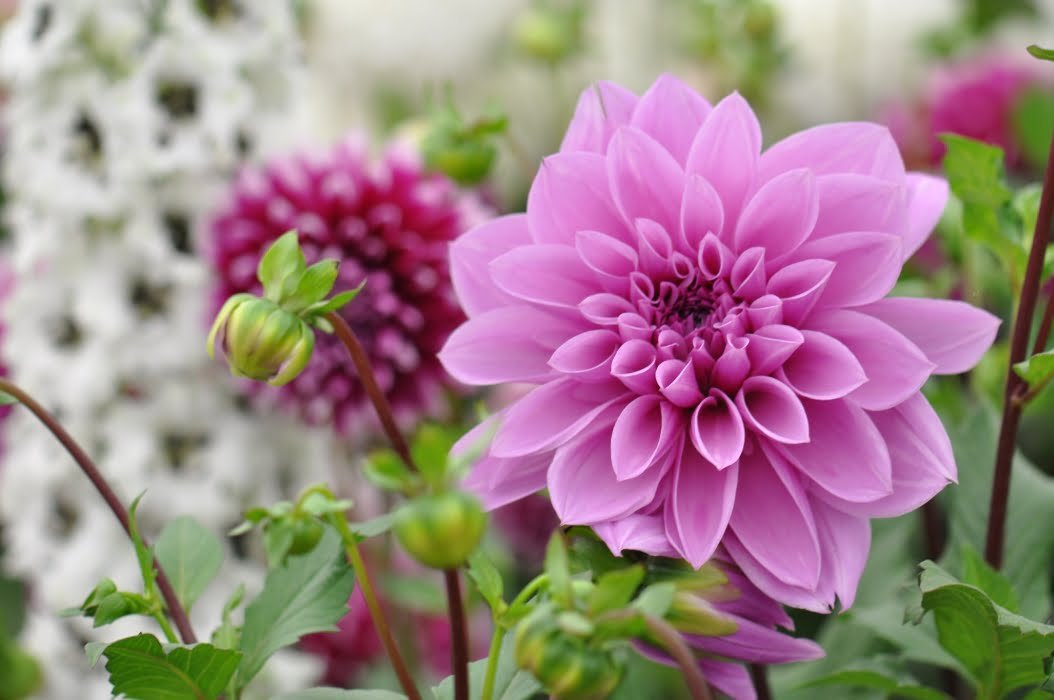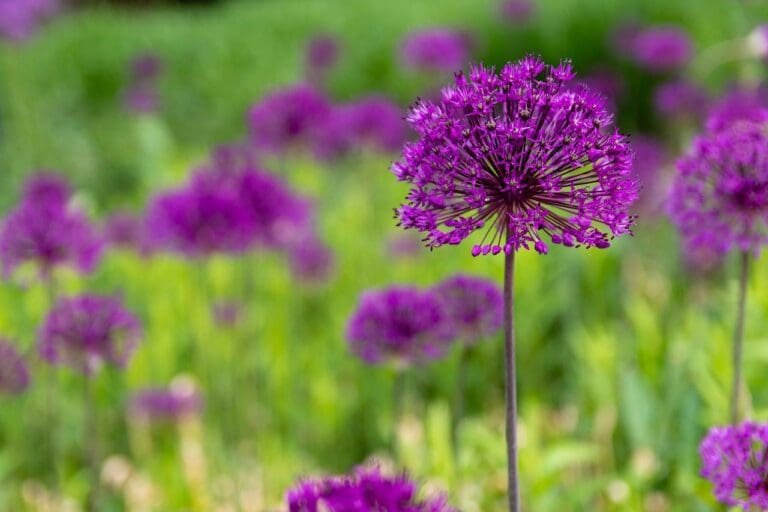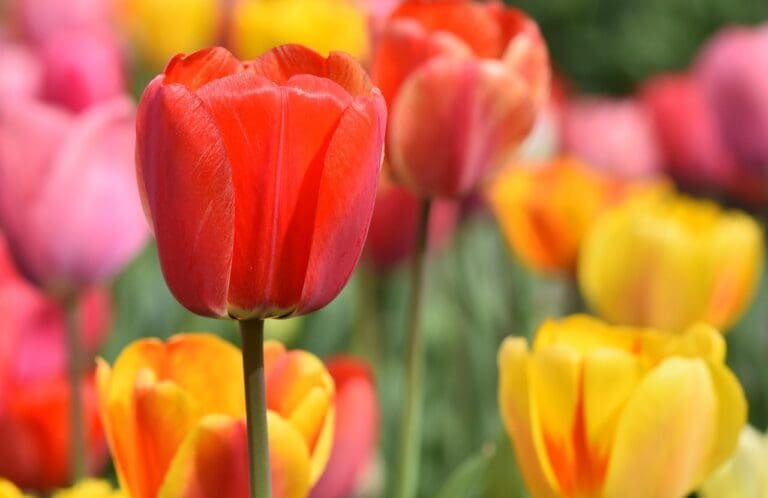Dahlias are one of the most popular flowers for gardens. With their showy, vibrant flowers in a huge range of colours, sizes and forms, it’s easy to understand their appeal to gardeners. But getting dahlias established and caring for them throughout the growing season does require some time and attention. This comprehensive guide will walk you through exactly how to grow dahlias successfully.
You might also be interested in: Summer Flowering Bulbs for Wild Gardens
Choosing the Right Dahlia Varieties
With over 20,000 registered dahlia cultivars, there seem to be endless options to choose from. But dahlias can generally be grouped into five main categories based on the shape of their flowers:
- Decorative dahlias have broad, flattened, loosely formed flowers with broad petals that are slightly curled or twisted. They bloom in all colours and work beautifully in gardens. Popular varieties include ‘Cafe Au Lait’, ‘Great Silence’, and ‘Jersey Beauty’.
- Cactus dahlias have noticeably pointed, narrow, twisted or curled petals. Often described as “spiky blossoms,” they add serious visual intrigue to gardens. ‘Clair de Lune’ and ‘Torch Everburning’ are classic cactus varieties.
- Ball or pompon dahlias produce round, ball-shaped flower heads made up of tightly packed, petal-like florets. The plants are usually very prolific bloomers. Well-known examples are ‘Amber Queen’ and ‘Lilac Time’.
- Anemone-flowered dahlias have one or more outer rings of usually flattened or slightly twisted guard petals surrounding a dense group of tubular petals that create a rounded centre, resembling a pincushion. Some popular options include ‘Abba’, ‘My Love’ and ‘Windrush Joy’.
- Single dahlias have flowers with a single outer ring of florets surrounding the central disc. The disc is often a different colour than the petals for a lovely bicolour effect. Try growing ‘Bednall Beauty’ or ‘Bishop of Llandaff’ for their striking red-black flowers.
The above groupings help narrow down options, but gardeners still need to choose between dwarf (under 60cm/2ft tall), mid-sized (60-90cm/2-3ft tall) and giant varieties (over 90cm/3ft tall) to best suit their needs. Bushy dwarf cultivars work well in containers while giant dahlias make impressive focal points within flowerbeds. Ask your local nursery for suggestions on varieties suited to your climate and growing conditions.
Planting Dahlia Tubers
Early spring is the perfect time to get dahlia tubers planted for bountiful blooms throughout summer and fall. You’ll need:
- Dahlia tubers or young plants
- Spade or garden fork
- Compost/organic matter
- Garden soil/potting mix
- Plant markers and labels
- Watering can
Wait until all danger of frost has passed before planting dahlia tubers outdoors. Dig a hole about 20cm/8in deep and mix in compost or other organic matter to improve drainage and nourish plants. Place the dahlia tuber in the hole horizontally, with the stem end just slightly above ground level and the eye (the spot where sprouts emerge) facing up. Cover tubers with 5-8cm/2-3in of soil and press gently. Space plants 45-60cm/18-24in apart to allow for growth.
Thoroughly water newly planted tubers. As sprouts begin to emerge in a couple of weeks, gently tamp soil around the base of each plant to anchor it. Apply an organic plant fertilizer at this time to encourage vigorous growth. Dahlia shoots are quite brittle so take care not to damage emerging plants.
Caring for Your Dahlia Plants
Adequate water and fertilizer is essential for dahlias to reach their full flowering potential. These fast-growing plants demand consistent moisture to support their dense foliage and profuse blooming habits. Water dahlia plants once or twice per week, applying approximately 2-3cm/1in of water each time. Use a garden fork or probe with a moisture meter to check soil moisture at root level. As plants grow, you may need to switch from gentle overhead watering with a sprayer to deep watering with soaker hoses or drip irrigation. This encourages stronger, healthier root development.
Every three to four weeks during the growing season, feed containerised or garden-grown dahlias with a water-soluble, balanced fertiliser. Alternate between formulas higher in nitrogen (the first number on the label) to promote lush foliage growth and higher in phosphorous and potassium to support prolific flowering. Always follow product instructions carefully and avoid fertilizer burn by not overapplying.
Pinching out the tips of young shoots when plants are about 46cm/18in tall will encourage bushier growth with more flowering stems. Insert stakes next to taller dahlia varieties as they grow to provide physical support once they are heavy with flowers. Deadheading spent blooms by removing faded flowers down to the next set of leaf nodes will neaten plants and promote extended flowering.
Protecting Dahlia Plants from Pests and Diseases
Unfortunately, the same conditions dahlias relish can also attract pests and diseases. Be on guard for potential problems and take action at the first signs of damage. Common dahlia troubles include:
- Slugs and snails – chew irregular holes in leaves and petals
- Aphids – clustered colonies of tiny sap-sucking insects on stems and undersides of leaves
- Botrytis blight or grey mould – fuzzy grey fungal growth on fading blooms and stems
- Powdery mildew – white fungal coating on leaves, causing curling
- Dahlia Mosaic Virus – yellow patterns on green leaves, stunted growth
Prevent issues before they take hold by:
- Removing garden debris and diseased material
- Avoiding overhead watering
- Allowing good airflow between plants
- Rotating planting sites yearly
If pests like slugs do appear, use organic baits or traps. Wash aphids off plants with a strong spray of water and treat with horticultural oil or insecticidal soap if needed. Remove and destroy any foliage or flowers showing signs of fungal disease. There is no cure for viral infections, so infected tubers must be discarded to prevent spreading. Consult local garden centres for product recommendations to keep dahlia concerns at bay.
Enjoying Your Dahlia Blooms
Expect most dahlias to begin flowering in mid-late summer, with peak blooming in early fall. Harvest flowers by snipping stems right above leaf joints using hand pruners, floral snips or garden shears. The best time is mid-morning once dew evaporates but before heat builds. Always cut blooms with plenty of attached stem length for maximum visual appeal and vase life.
Condition freshly cut stems by plunging them immediately into warm water up to the neck of the bloom. Let them rehydrate for at least six hours, or ideally overnight, away from direct sunlight. Prepare a clean vase filled with room temperature water mixed with floral preservative. Recut stems by a few inches and arrange blooms as desired. Display indoors out of excessive heat to prolong their beauty.
FAQs: How To Grow Dahlias
Q. When is the best time to plant dahlia tubers?
The ideal time to plant dahlia tubers outdoors is after all danger of frost, when soil temperatures have warmed to 60°F/15°C and above. This is usually early to mid spring in most climates. Indoors, tubers can be started about 4-6 weeks before the last expected frost date.
Q. How often should I water my dahlia plants?
Established dahlias should be thoroughly watered to a depth of at least 20cm/8in about twice per week. More frequent watering may be needed for containerised plants, or in periods of drought or extreme summer heat when rainfall is sparse.
Q. How can I protect my dahlia plants from pests and diseases?
Prevent issues by removing plant debris, avoiding overhead watering, improving airflow and rotating planting sites yearly. Address emerging problems quickly by handpicking pests, pruning diseased material and using organic treatments if infestations persist.
Q. What are some of the best dahlia varieties for beginners?
Beginner gardeners may want to start with prolific flowering dwarf bedding dahlias like ‘Gallery Art Deco’ and ‘Gallery Pablo’ which grow just 30-45cm/12-18in tall. Mid-sized varieties like ‘Cafe Au Lait’, ‘Great Silence’ and ‘Hillcrest Royal’ are also fairly easy-care, reliable bloomers year after year.



